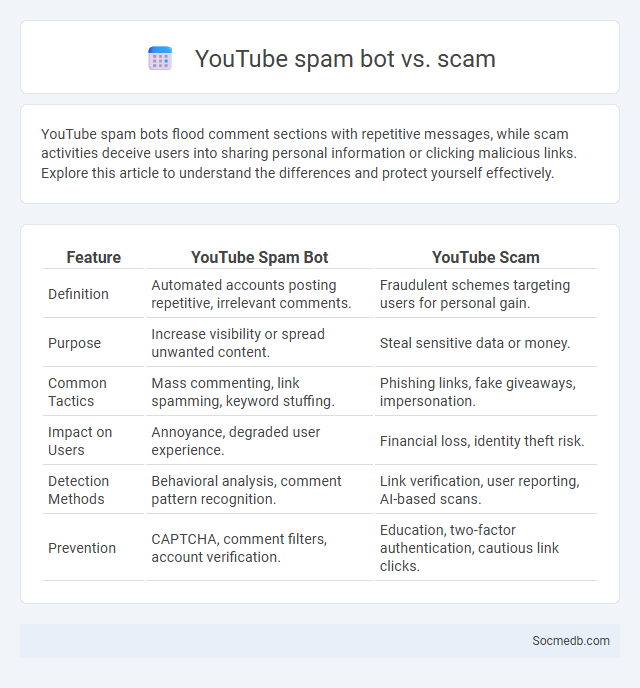
Photo illustration: YouTube spam bot vs scam
YouTube spam bots flood comment sections with repetitive messages, while scam activities deceive users into sharing personal information or clicking malicious links. Explore this article to understand the differences and protect yourself effectively.
Table of Comparison
| Feature | YouTube Spam Bot | YouTube Scam |
|---|---|---|
| Definition | Automated accounts posting repetitive, irrelevant comments. | Fraudulent schemes targeting users for personal gain. |
| Purpose | Increase visibility or spread unwanted content. | Steal sensitive data or money. |
| Common Tactics | Mass commenting, link spamming, keyword stuffing. | Phishing links, fake giveaways, impersonation. |
| Impact on Users | Annoyance, degraded user experience. | Financial loss, identity theft risk. |
| Detection Methods | Behavioral analysis, comment pattern recognition. | Link verification, user reporting, AI-based scans. |
| Prevention | CAPTCHA, comment filters, account verification. | Education, two-factor authentication, cautious link clicks. |
Understanding YouTube Spam Bots: Definition and Purpose
YouTube spam bots are automated programs designed to post repetitive, irrelevant, or misleading comments and content on videos, often to manipulate views, likes, or influence algorithmic recommendations. These bots degrade user experience by flooding comment sections with promotions, fake accounts, or harmful links, undermining authentic engagement. Understanding their purpose helps you better identify and avoid suspicious activity on the platform, ensuring safer and more genuine interactions.
What is a Scam on YouTube? Key Characteristics
A scam on YouTube involves deceptive content designed to trick viewers into providing personal information, money, or clicking malicious links. Key characteristics include fake giveaways, impersonation of legitimate channels, false promises of rewards, and misleading thumbnails aimed at generating clicks. Protect Yourself by verifying channel authenticity and avoiding sharing sensitive information.
Differentiating Spam Bots from Scam Bots on YouTube
Spam bots on YouTube primarily flood comment sections with repetitive or irrelevant messages to increase visibility, often using automated scripts to exploit the platform's algorithms. Scam bots, however, are designed to deceive users by impersonating trustworthy accounts or posting fraudulent links that lead to phishing sites or malware downloads. Effective differentiation relies on analyzing behavioral patterns, such as the frequency and context of posts, account creation dates, and the nature of links shared, enabling more accurate detection and mitigation strategies.
Common Tactics Used by YouTube Spam Bots
YouTube spam bots commonly use tactics like posting repetitive comments with misleading links to drive traffic to external sites and inflate views artificially. These bots often exploit trending video tags and popular hashtags to increase visibility and evade detection by YouTube's spam filters. Automated accounts also deploy fake engagement methods such as mass liking and subscribing, aiming to manipulate algorithmic rankings and deceive users.
How YouTube Scam Bots Operate: Methods and Techniques
YouTube scam bots operate by leveraging automated scripts to generate fake views, likes, and comments, artificially inflating engagement metrics to mislead users and advertisers. These bots often use click farms, proxy servers, and account hijacking to bypass YouTube's security measures and mimic legitimate activity patterns. Techniques include spamming links to fraudulent websites, impersonating popular channels, and exploiting trending topics to maximize reach and deceive unsuspecting viewers.
Types of Spam Bots Found on YouTube
YouTube faces various types of spam bots including comment spam bots that flood videos with irrelevant or promotional messages, view bots that artificially inflate video views to manipulate popularity, and subscriber bots that create fake subscribers to boost channel statistics. These spam bots undermine the platform's authenticity, disrupt genuine user engagement, and violate YouTube's community guidelines. Continuous improvements in AI detection and user reporting systems are crucial for mitigating the impact of such spam activities on YouTube.
Identifying Red Flags: Spam Bot vs Scam Bot Interaction
Recognizing the difference between spam bot and scam bot interaction on social media is crucial for maintaining online security and engagement quality. Spam bots typically flood feeds with irrelevant or promotional content, while scam bots often attempt to deceive users like you by impersonating legitimate sources to steal personal information or money. Monitoring unusual behaviors such as repetitive messaging, suspicious links, and unsolicited contact helps swiftly identify these red flags and protect your digital presence.
The Impact of YouTube Spam and Scam Bots on Users
YouTube spam and scam bots flood the platform with misleading links and deceptive content, undermining user trust and safety. These bots manipulate the algorithm to amplify fraudulent videos, resulting in increased exposure to scams and phishing attempts. The proliferation of such malicious activities disrupts authentic user engagement and compromises the overall integrity of the YouTube community.
How to Protect Yourself from YouTube Spam and Scam Bots
Protect yourself from YouTube spam and scam bots by enabling two-factor authentication and regularly updating your privacy settings to restrict who can comment and message you. Use trusted antivirus software and avoid clicking on suspicious links or downloading unverified files shared via comments or direct messages. Report spam accounts immediately and subscribe only to verified or reputable channels to minimize exposure to malicious content.
YouTube’s Efforts to Combat Spam and Scam Bots
YouTube employs advanced machine learning algorithms to detect and remove spam and scam bots that compromise user experience and platform integrity. The platform continuously updates its policies and uses real-time monitoring systems to identify malicious activities, such as fake comments, fraudulent links, and spammy accounts. Collaboration with cybersecurity experts and community reporting further strengthens YouTube's efforts to maintain a safe and authentic environment for millions of users worldwide.
 socmedb.com
socmedb.com